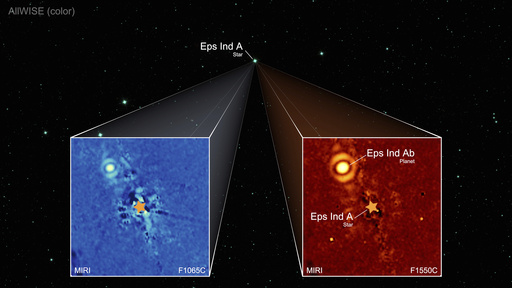CAPE CANAVERAL, Fla. (AP) — A super Jupiter has been spotted around a neighboring star by the Webb Space Telescope — and it has a super orbit.
The planet is roughly the same diameter as Jupiter, but with six times the mass. Its atmosphere is also rich in hydrogen like Jupiter’s.
One big difference: It takes this planet more than a century, possibly as long as 250 years, to go around its star. It’s 15 times the distance from its star than Earth is to the sun.
Scientists had long suspected a big planet circled this star 12 light-years away, but not this massive or far from its star. A light-year is 5.8 trillion miles. These new observations show the planet orbits the star Epsilon Indi A, part of a three-star system.
An international team led by Max Planck Institute for Astronomy’s Elisabeth Matthews in Germany collected the images last year and published the findings Wednesday in the journal Nature.
Astronomers directly observed the incredibly old and cold gas giant — a rare and tricky feat — by masking the star through use of a special shading device on Webb. By blocking the starlight, the planet stood out as a pinpoint of infrared light.
The planet and star clock in at 3.5 billion years old, 1 billion years younger than our own solar system, but still considered old and brighter than expected, according to Matthews.
The star is so close and bright to our own solar system that it’s visible with the naked eye in the Southern Hemisphere.
Don’t bet on life, though.
“This is a gas giant with no hard surface or liquid water oceans,” Matthews said in an email.
It’s unlikely this solar system sports more gas giants, she said, but small rocky worlds could be lurking there.
Worlds similar to Jupiter can help scientists understand “how these planets evolve over giga-year timescales,” she said.
The first planets outside our solar system — dubbed exoplanets — were confirmed in the early 1990s. NASA’s tally now stands at 5,690 as of mid-July. The vast majority were detected via the transit method, in which a fleeting dip in starlight, repeated at regular intervals, indicates an orbiting planet.
Telescopes in space and also on the ground are on the hunt for even more, especially planets that might be similar to Earth.
Launched in 2021, NASA and the European Space Agency’s Webb telescope is the biggest and most powerful astronomical observatory ever placed in space.
___
The Associated Press Health and Science Department receives support from the Howard Hughes Medical Institute’s Science and Educational Media Group. The AP is solely responsible for all content.
This website uses cookies so that we can provide you with the best user experience possible. Cookie information is stored in your browser and performs functions such as recognising you when you return to our website and helping our team to understand which sections of the website you find most interesting and useful.
